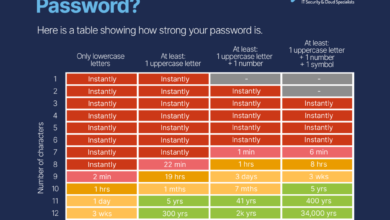
Ransomware Attack Shuts Down JBS Meat Processing
Suspected ransomware attack shuts down JBS meat processing – a headline that sent shockwaves through the global food industry. This massive cyberattack wasn’t just a technical glitch; it exposed the vulnerabilities of a critical part of our food supply chain, highlighting the real-world consequences of increasingly sophisticated cybercrime. The ripple effects were immediate and far-reaching, impacting not only JBS but also countless businesses and consumers.
Let’s dive into the details of this significant event and explore the lessons learned.
The attack crippled JBS’s operations, halting meat production across North America and causing widespread disruption. This wasn’t just about lost profits; it’s about empty shelves, rising prices, and questions about the security of our food system. The incident forced a critical conversation about cybersecurity in the food industry, a sector often overlooked in the broader discussion of cyber threats.
We’ll examine the technical aspects of the attack, JBS’s response, and the long-term implications for businesses and consumers alike.
Impact on JBS and the Meat Industry

The suspected ransomware attack on JBS, a global meat processing giant, caused immediate and widespread disruption across its operations. The attack, which crippled its IT systems, effectively halted production at numerous facilities across North America, Australia, and potentially other regions. This had a cascading effect, impacting not only JBS itself but the entire meat supply chain.
Operational Disruptions at JBS
The immediate impact on JBS was a complete shutdown of its meat processing plants. This resulted in a significant backlog of livestock, forcing ranchers and farmers to either hold onto animals longer than usual or find alternative (and likely less profitable) ways to sell them. The inability to process and distribute meat led to empty shelves in supermarkets and restaurants, creating shortages and price increases for consumers.
Beyond production, the attack also affected JBS’s logistics, accounting, and customer service operations, hindering its ability to manage its business effectively. The scale of the disruption was immense, showcasing the vulnerability of a globally integrated company to cyberattacks.
Long-Term Economic Consequences for JBS
The long-term consequences for JBS are potentially severe. The financial losses from lost production, remediation costs, potential legal battles, and reputational damage could be substantial. The company faced significant costs in recovering its systems, paying ransom (the amount remains undisclosed but was reportedly substantial), and dealing with the fallout. Moreover, the disruption could lead to a loss of market share as competitors capitalize on the opportunity.
JBS’s recovery will require a significant investment in cybersecurity infrastructure and a robust incident response plan, adding further to its financial burden. The incident serves as a cautionary tale of the high cost of neglecting cybersecurity.
Ripple Effects on the Meat Industry
The JBS attack had significant ripple effects throughout the meat processing and distribution industries. The disruption in supply led to increased prices for beef, pork, and poultry, impacting consumers and businesses alike. Smaller meat processors and distributors experienced a surge in demand, but many lacked the capacity to fully meet it. The incident highlighted the interconnectedness of the global food supply chain and the vulnerability of the entire system to major disruptions.
The long-term impact could include increased prices, supply chain instability, and a renewed focus on cybersecurity within the industry.
Comparison to Other Significant Ransomware Attacks
This incident is not unique. Several major corporations have faced crippling ransomware attacks in recent years, highlighting the growing threat of cybercrime. The following table provides a comparison:
| Company | Year | Industry | Estimated Financial Impact |
|---|---|---|---|
| Colonial Pipeline | 2021 | Energy | >$4.4 million (ransom paid) + operational costs |
| JBS | 2021 | Food Processing | Undisclosed, but likely tens of millions of dollars |
| NotPetya | 2017 | Various | Estimated $10 billion globally |
| Maersk | 2017 | Shipping | Estimated $300 million |
The Ransomware Attack’s Technical Aspects
The JBS ransomware attack, while causing significant disruption, also provides a valuable case study in understanding modern ransomware techniques. Analyzing the attack’s technical aspects helps us learn how to better protect against similar incidents in the future. This examination will focus on the likely ransomware variant, the probable entry point, the methods of encryption and disruption, and potential indicators of compromise.The specific ransomware variant used in the JBS attack remains officially unconfirmed, however, based on the scale and impact, it was likely a highly sophisticated and capable strain.
Several families of ransomware, such as REvil (also known as Sodinokibi), Conti, and DarkSide, have been known to target large corporations with devastating effect. These strains often employ advanced techniques for lateral movement within a network and data encryption, maximizing their impact and making recovery difficult. The attackers likely chose a variant capable of encrypting a large number of files quickly and efficiently, targeting critical systems and databases responsible for operational control and financial records.
Possible Ransomware Variant Characteristics
The ransomware used probably possessed several key characteristics. It would have included robust encryption algorithms, making decryption without the decryption key extremely challenging. It likely incorporated self-propagation capabilities, allowing it to spread rapidly throughout the JBS network. Furthermore, it likely included mechanisms to evade detection by security software, using techniques such as polymorphism or obfuscation. The ransomware would have also incorporated a command-and-control (C2) server, allowing the attackers to remotely manage the attack and potentially exfiltrate data before encryption.
This exfiltration, a common tactic, allows attackers to use stolen data as leverage, even if the encryption is eventually overcome.
Likely Entry Point
The attackers likely gained initial access through a combination of techniques, exploiting vulnerabilities in JBS’s systems or leveraging compromised credentials. Phishing emails, targeting employees with malicious attachments or links, remain a common vector. Exploiting unpatched software vulnerabilities, particularly in remote desktop protocol (RDP) services or other network services, is another highly probable entry point. It’s also possible that the attackers gained access through a third-party vendor with less robust security measures, a common vulnerability in supply chain attacks.
Data Encryption and Operational Disruption Techniques
Once inside the network, the attackers likely used lateral movement techniques to gain access to critical systems and databases. This could involve exploiting domain controllers or using stolen credentials to move between systems. The encryption process itself would have been designed to be fast and efficient, targeting file types crucial to JBS’s operations, such as databases, financial records, and operational control systems.
The attackers might have used a combination of techniques to disrupt operations, such as deleting system files or manipulating critical configuration settings. This dual approach of encryption and disruption maximizes the pressure on the victim to pay the ransom.
Potential Indicators of Compromise (IOCs)
Security professionals investigating the attack would have looked for several IOCs. These would include unusual network traffic patterns, indicating communication with a C2 server. The presence of unusual or malicious files on the network, including the ransomware executable itself, would have been a key indicator. Log files showing suspicious activity, such as unauthorized access attempts or changes to system configurations, would also have been thoroughly examined.
Finally, the identification of encrypted files with specific file extensions or patterns associated with known ransomware families would have confirmed the nature of the attack. Analyzing these IOCs would help to identify the ransomware variant and understand the attackers’ techniques.
JBS’s Response and Recovery Efforts
The ransomware attack on JBS, one of the world’s largest meat processing companies, triggered a swift and multifaceted response. The company’s actions in the immediate aftermath and subsequent recovery efforts highlight the complexities of dealing with a large-scale cyberattack and the critical importance of a robust incident response plan. Their experience offers valuable lessons for other organizations facing similar threats.The initial response focused on containment and damage limitation.
JBS immediately shut down affected systems to prevent further spread of the malware. This involved a coordinated effort across their IT infrastructure, impacting operations globally. Simultaneously, they initiated contact with law enforcement and cybersecurity experts to assist in investigation and recovery. This rapid response was crucial in minimizing the long-term impact of the attack.
JBS’s Decision Regarding Ransom Payment
JBS ultimately decided to pay the ransom demanded by the attackers. This decision, while controversial, was likely made after careful consideration of the potential costs of a prolonged shutdown versus the financial and reputational implications of a ransomware payment. The immediate impact on their global operations, including supply chain disruptions and potential financial losses, likely played a significant role in this decision.
The decision-making process involved weighing the short-term financial costs against the long-term consequences of a prolonged outage, including potential losses in revenue, market share, and customer trust. It’s important to note that paying a ransom doesn’t guarantee the complete recovery of data or prevent future attacks.
Data Recovery and System Restoration Strategies
Following the payment, JBS worked closely with cybersecurity experts to restore their systems and recover critical data. This involved a combination of strategies, including using backups (where available), employing data recovery tools, and rebuilding affected systems from scratch. The process was likely complex and time-consuming, requiring the coordination of numerous teams and resources. The restoration process likely involved rigorous security checks to ensure the systems were clean of any remaining malware before being brought back online.
The company likely prioritized the restoration of critical systems and data related to production and supply chain management, gradually bringing other systems back online as they were secured and validated.
Best Practices for Ransomware Incident Response, Suspected ransomware attack shuts down jbs meat processing
The JBS incident underscores the need for proactive measures and a well-defined incident response plan. Based on their experience, several best practices for ransomware incident response emerge:
- Proactive Security Measures: Implement robust cybersecurity defenses, including multi-factor authentication, regular software updates, employee security awareness training, and advanced threat detection systems.
- Incident Response Plan: Develop and regularly test a comprehensive incident response plan that Artikels clear roles, responsibilities, and procedures for handling a ransomware attack.
- Regular Backups: Maintain frequent and secure backups of critical data, stored offline and in a separate location, to enable rapid recovery in the event of an attack.
- Network Segmentation: Segment the network to limit the impact of a breach, preventing the spread of malware to other systems.
- Threat Intelligence: Stay informed about emerging ransomware threats and vulnerabilities to proactively mitigate risks.
- Collaboration with Experts: Engage with cybersecurity professionals and law enforcement agencies for assistance in investigating and recovering from an attack.
- Communication Strategy: Develop a communication plan to keep stakeholders informed during and after the incident.
- Post-Incident Review: Conduct a thorough post-incident review to identify weaknesses and improve security measures.
Legal and Regulatory Implications

The JBS ransomware attack had significant legal and regulatory ramifications, extending far beyond the immediate financial losses. The incident triggered a cascade of potential liabilities for the company, prompting intense scrutiny from both private litigants and government agencies. Understanding these implications is crucial for any organization aiming to mitigate the legal risks associated with a ransomware attack.The potential for lawsuits against JBS is substantial.
Affected customers, suppliers, and even employees could file suits alleging negligence, breach of contract, or violation of data privacy laws. These lawsuits could stem from disruptions to the meat supply chain, financial losses due to production halts, or unauthorized access to sensitive personal data. The scale of the JBS operation and the widespread disruption caused by the attack magnify the potential for a large number of costly legal battles.
Potential Lawsuits Against JBS
The legal landscape for ransomware attacks is complex and evolving. JBS could face class-action lawsuits from individuals affected by the attack, particularly if personal information was compromised. Suppliers who experienced financial losses due to delayed payments or cancelled contracts could also pursue legal action. Additionally, JBS might face lawsuits from shareholders alleging mismanagement or failure to adequately protect company assets.
The outcome of these lawsuits will depend on several factors, including the strength of the evidence demonstrating negligence on JBS’s part and the specifics of the applicable laws and regulations. For example, if JBS failed to implement reasonable security measures, as determined by industry best practices and relevant regulations, they would be more vulnerable to legal action. The precedents set in similar cases, such as the Colonial Pipeline ransomware attack, will also play a significant role in shaping the legal responses to the JBS incident.
Regulatory Scrutiny of JBS
Beyond potential civil lawsuits, JBS faced intense regulatory scrutiny from various government agencies. Data protection authorities in the countries where JBS operates, including the United States, Brazil, and potentially others, would likely investigate the incident to assess compliance with data security regulations like the GDPR (in Europe), CCPA (in California), and other relevant national and international laws. These investigations could lead to significant fines and penalties if JBS is found to have violated data protection or cybersecurity regulations.
Furthermore, regulatory bodies overseeing food safety and supply chain security could also launch investigations to determine whether the attack compromised the safety and integrity of the meat supply. This type of regulatory scrutiny highlights the importance of robust cybersecurity practices and compliance programs for companies operating in a globally connected environment.
Comparison with Similar Ransomware Attacks
The legal responses to the JBS attack can be compared to those following similar high-profile ransomware incidents, such as the Colonial Pipeline attack and the attacks on municipalities and healthcare providers. In each case, the affected organizations faced a mix of civil lawsuits and regulatory investigations, resulting in substantial financial penalties and reputational damage. However, the specific legal outcomes varied depending on factors like the extent of the damage, the organization’s preparedness, and the applicable legal frameworks.
The JBS case offers valuable insights into the evolving legal landscape surrounding ransomware attacks and underscores the need for proactive cybersecurity measures and comprehensive incident response plans.
Legal and Regulatory Considerations for Companies Facing Ransomware Attacks
The experience of JBS highlights the importance of proactive measures to mitigate the legal and regulatory risks associated with ransomware attacks. Companies should consider the following:
- Implementing robust cybersecurity measures, including regular security audits, employee training, and multi-factor authentication.
- Developing a comprehensive incident response plan that includes legal and regulatory considerations.
- Maintaining thorough records of security practices and incident response actions.
- Cooperating fully with law enforcement and regulatory agencies during investigations.
- Conducting regular legal reviews to ensure compliance with all applicable data privacy and cybersecurity laws.
- Maintaining cyber insurance coverage to help mitigate financial losses and legal costs.
- Developing a communication strategy for interacting with affected parties and the public.
Cybersecurity Lessons Learned: Suspected Ransomware Attack Shuts Down Jbs Meat Processing
The JBS ransomware attack served as a stark reminder of the vulnerabilities within critical infrastructure and the devastating consequences of inadequate cybersecurity. This incident highlighted the urgent need for improved security practices across the meat processing industry and beyond, emphasizing the interconnectedness of our digital and physical worlds. The attack exposed significant weaknesses in JBS’s systems, providing valuable lessons for organizations of all sizes.The attack underscored several key vulnerabilities.
The JBS meat processing shutdown due to a suspected ransomware attack highlights the vulnerability of even massive corporations. Building resilient systems is crucial, and that’s where exploring options like domino app dev the low code and pro code future becomes incredibly relevant. Faster development cycles and improved security could be key to mitigating future ransomware threats, ensuring business continuity in the face of similar attacks against JBS or other large companies.
Firstly, JBS’s reliance on legacy systems and insufficient network segmentation allowed the ransomware to spread rapidly throughout their network. Secondly, a lack of robust multi-factor authentication (MFA) likely facilitated initial access for the attackers. Thirdly, inadequate employee cybersecurity training may have contributed to phishing attacks or other social engineering techniques succeeding. Finally, the absence of a comprehensive and regularly tested backup and recovery plan significantly prolonged the disruption and increased the overall cost of recovery.
Vulnerabilities Exposed and Mitigation Strategies
Improved cybersecurity practices could have significantly mitigated the impact of the JBS attack. Implementing robust network segmentation would have limited the ransomware’s spread, preventing it from affecting critical systems. Mandatory multi-factor authentication across all systems would have made unauthorized access far more difficult. A comprehensive employee cybersecurity awareness program, including regular phishing simulations, would have reduced the likelihood of successful social engineering attacks.
Finally, a well-tested backup and recovery plan, stored offline, would have allowed for a much quicker restoration of services, minimizing downtime and financial losses. The implementation of a Zero Trust security model, where every user and device is authenticated and authorized before accessing resources, regardless of network location, would have further strengthened security.
Strengthening Cybersecurity Defenses in the Meat Processing Industry
A multi-pronged approach is necessary to strengthen cybersecurity defenses within the meat processing industry. This should include mandatory cybersecurity assessments and penetration testing for all facilities, regular updates of software and operating systems, and the implementation of advanced threat detection systems. Furthermore, collaboration and information sharing between companies within the industry are crucial for identifying emerging threats and sharing best practices.
Government agencies can play a role by providing resources and incentives for companies to improve their cybersecurity posture. Industry-wide standards and regulations should be considered to enforce minimum security requirements.
Advanced Cybersecurity Technologies for Enhanced Protection
Several advanced cybersecurity technologies could significantly enhance protection against ransomware attacks. Endpoint Detection and Response (EDR) solutions can monitor system activity for malicious behavior and provide real-time alerts. Security Information and Event Management (SIEM) systems can aggregate security logs from various sources to identify patterns and potential threats. Threat intelligence platforms can provide insights into emerging ransomware threats and help organizations proactively mitigate risks.
Blockchain technology can be used to create immutable records of data, making it more difficult for attackers to tamper with or encrypt sensitive information. Furthermore, the use of AI-powered security tools for anomaly detection and threat response can improve efficiency and effectiveness in combating cyber threats. The adoption of these technologies requires significant investment and expertise, but the potential return on investment in terms of reduced downtime and financial losses is substantial.
Public Perception and Consumer Confidence
The JBS ransomware attack, while ultimately resolved without significant long-term disruption to meat production, left a considerable mark on public perception. The sheer scale of the attack, impacting a global meat processing giant, raised serious concerns about food supply chain security and the vulnerability of critical infrastructure to cyberattacks. This event served as a stark reminder of the interconnectedness of our food system and the potential for disruptions to have far-reaching consequences.The immediate impact was a surge in anxiety surrounding food safety and availability.
Consumers, already grappling with fluctuating food prices and supply chain challenges, worried about potential shortages and the safety of JBS products. News reports fueled speculation about potential contamination or disruptions to the cold chain, further exacerbating these concerns. The incident highlighted the lack of transparency often surrounding food supply chains and the potential for unseen vulnerabilities to compromise the safety and availability of food.
Consumer Concerns Regarding Food Safety and Supply Chain Security
The ransomware attack directly impacted consumer trust in the safety and security of the meat supply chain. The fear wasn’t just about potential product contamination (which, thankfully, didn’t materialize), but also about the potential for broader systemic disruptions. Consumers questioned the resilience of the food system in the face of sophisticated cyberattacks and whether companies like JBS had adequate safeguards in place.
This uncertainty led some consumers to seek alternative sources of meat, potentially impacting JBS’s market share even after the crisis subsided. The incident underscored the need for increased transparency and better communication from food companies about their cybersecurity practices and supply chain resilience. A lack of clear, concise information from JBS during the crisis only amplified these anxieties.
JBS’s Strategies for Regaining Consumer Trust
Regaining consumer trust required a multi-pronged approach for JBS. First, and foremost, was a commitment to complete transparency. This involved promptly and openly communicating the extent of the attack, the steps taken to mitigate it, and the measures implemented to prevent future incidents. JBS needed to demonstrate a proactive approach to cybersecurity, investing in advanced technologies and training programs to enhance its defenses.
Secondly, JBS had to emphasize its commitment to food safety and quality. This could involve enhanced testing protocols, increased transparency about its supply chain, and potentially even independent audits to assure consumers of its commitment to safety standards. Finally, a robust public relations campaign could help to counter negative perceptions and highlight JBS’s efforts to improve its cybersecurity posture and protect its operations.
This campaign should involve clear, consistent messaging across multiple channels, actively engaging with consumers’ concerns and demonstrating a genuine commitment to their safety and well-being. Successful examples of similar recovery strategies can be found in other industries, particularly in cases of product recalls or major safety incidents, where companies proactively addressed concerns and demonstrated a commitment to transparency.
Effective Communication and Transparency During and After a Ransomware Attack
Effective communication is crucial during and after a ransomware attack. JBS should have immediately released a clear, concise statement acknowledging the attack and outlining the steps being taken to address it. Regular updates, delivered through multiple channels (website, social media, press releases), should have kept the public informed without fueling panic. Open communication about the impact on operations, timelines for recovery, and any potential disruptions to the supply chain was vital.
Transparency regarding the investigation, including cooperation with law enforcement and cybersecurity experts, would have further demonstrated a commitment to accountability. By proactively engaging with consumers’ concerns, JBS could have mitigated the spread of misinformation and demonstrated a commitment to responsible business practices. The contrast between JBS’s initial response and the more comprehensive communication strategies adopted by other companies in similar situations highlights the importance of having a well-rehearsed crisis communication plan in place.
Last Word

The JBS ransomware attack serves as a stark reminder of the growing threat of cybercrime and its potential to disrupt even the most essential industries. The incident highlighted the need for robust cybersecurity measures, proactive incident response planning, and transparent communication during and after a crisis. While JBS ultimately resumed operations, the lingering effects of this attack—from financial losses to damaged consumer confidence—underscore the critical importance of investing in and prioritizing cybersecurity.
The lessons learned from this event are crucial for all businesses, regardless of size or industry, emphasizing the need for vigilance and preparedness in the face of escalating cyber threats.
Essential FAQs
What type of ransomware was used in the JBS attack?
The specific ransomware variant used in the JBS attack hasn’t been publicly confirmed. Investigations often keep such details confidential to prevent future attacks.
Did JBS pay the ransom?
Reports suggest JBS did pay a ransom, though the exact amount remains undisclosed. Paying ransoms is a complex decision with ethical and legal implications.
What long-term effects will this have on meat prices?
The attack likely contributed to short-term price increases. The long-term impact depends on various factors including supply chain recovery and overall market conditions.
How can businesses in the food industry improve their cybersecurity?
Implementing multi-factor authentication, regular software updates, employee cybersecurity training, and robust backup systems are crucial steps.





